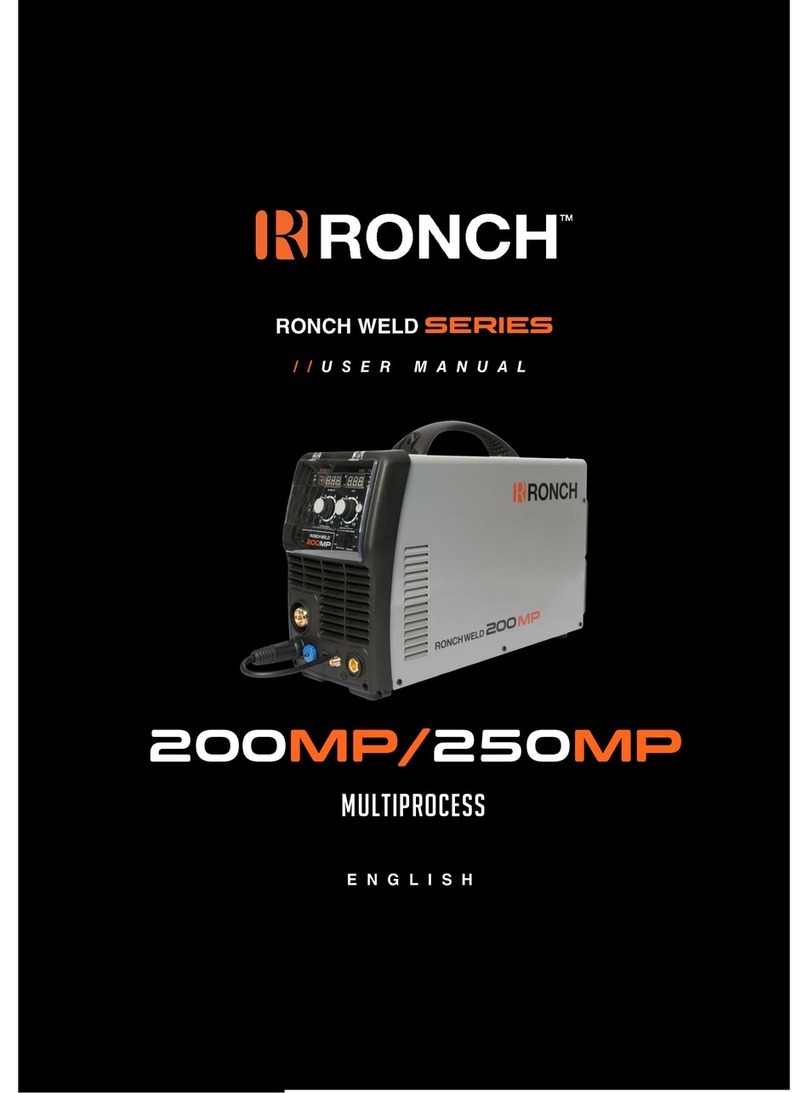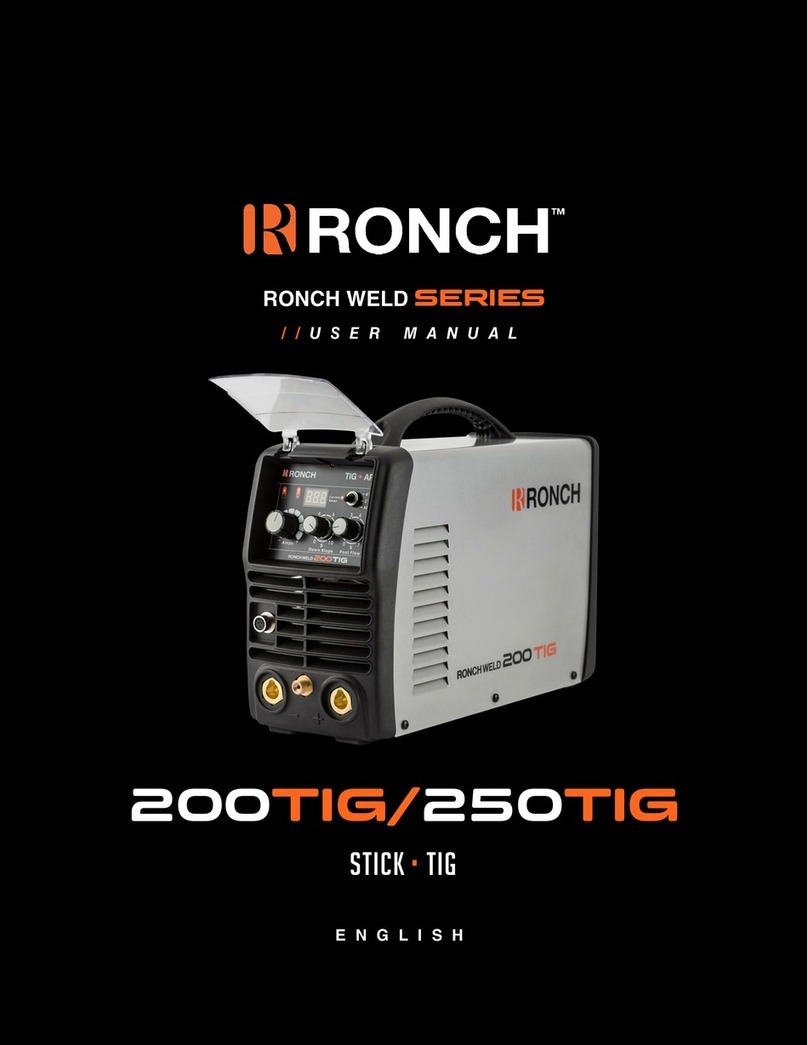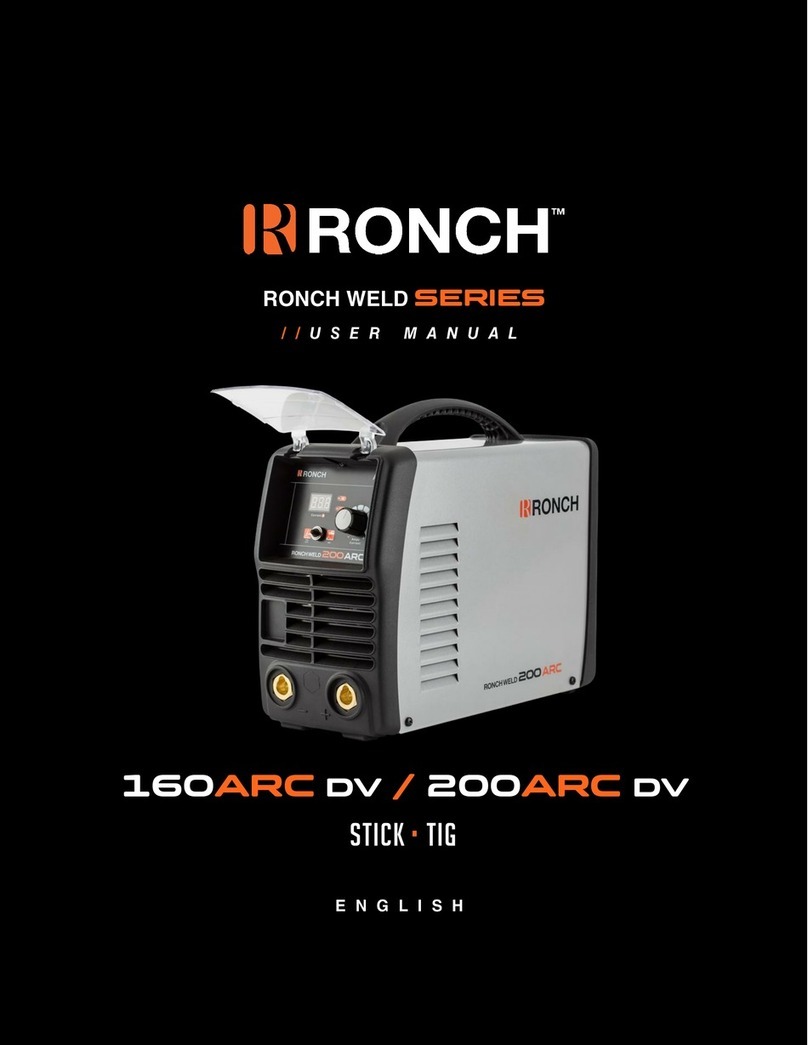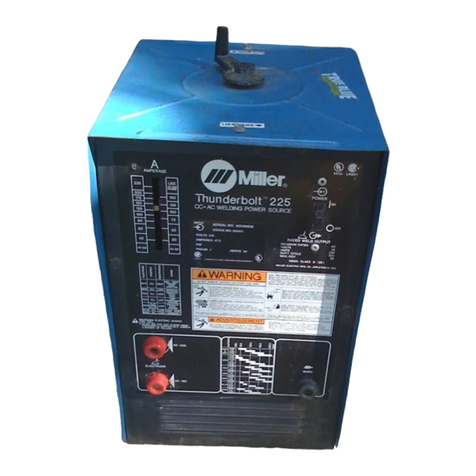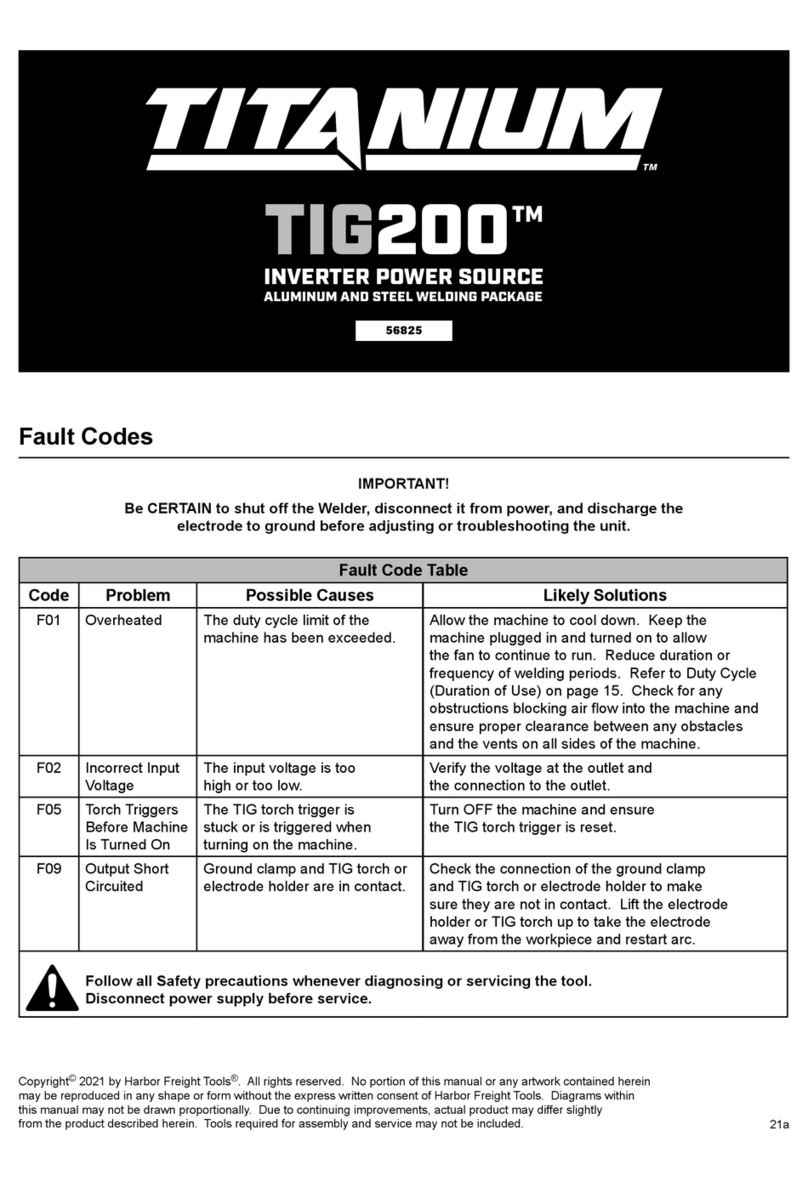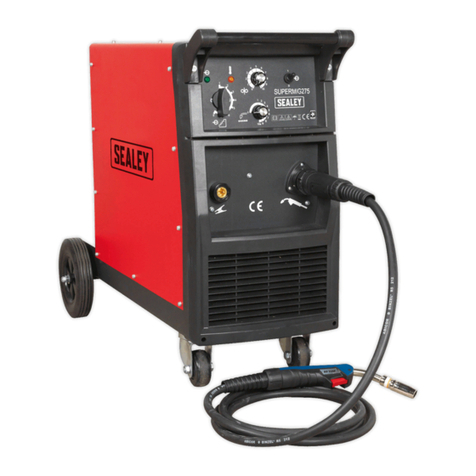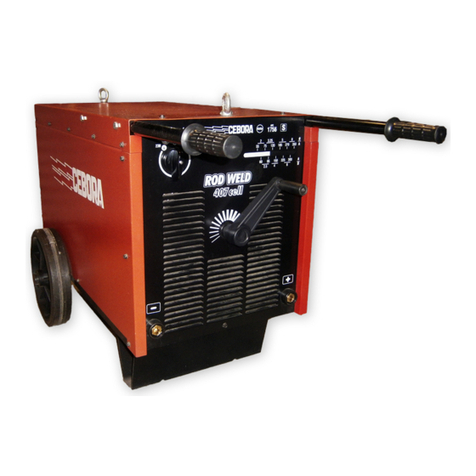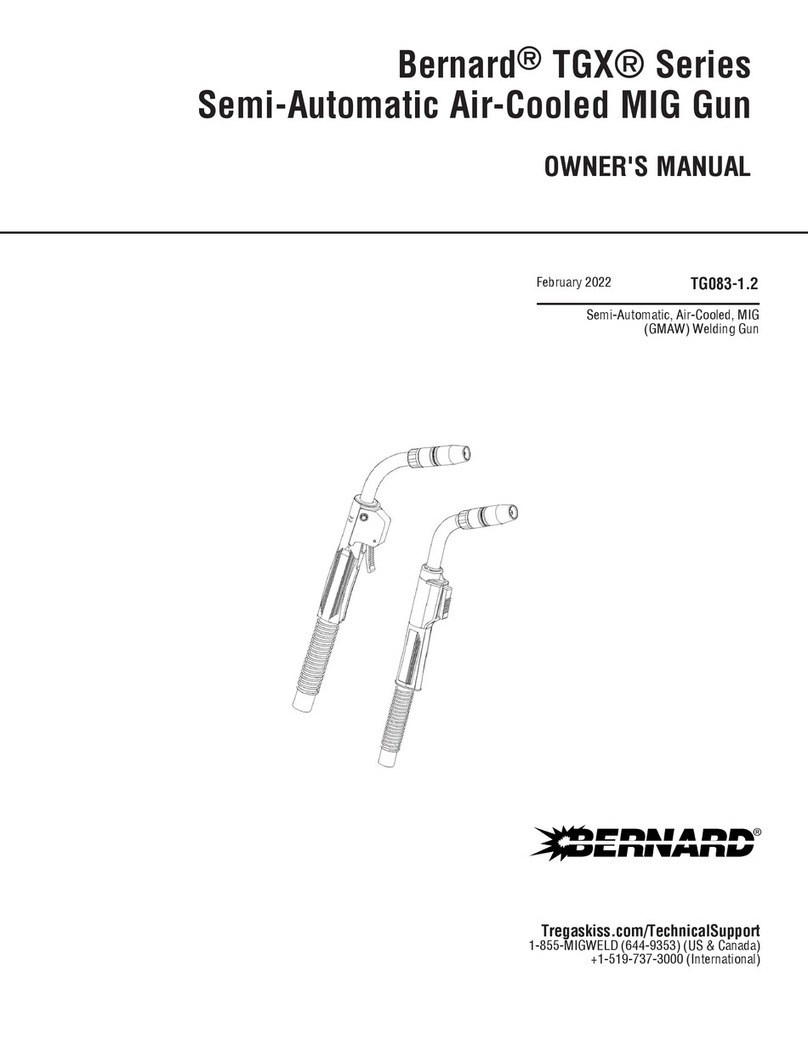Ronch RAPTOR DUTY R500MP User manual

1
R500MP
MULTIPROCESS

2
CONTENT
1. Safety •4
1.1. Symbols Explanation •4
1.2. Arc Welding warnings •4
1.3. Knowledge of Electric and Magnetic Fields •7
2. OVERVIEW •8
2.1. Brief Introduction •8
2.2. Working Principle •8
2.3. Volt-Ampere Characteristic •9
2.4. Volt-Ampere Characteristic •10
3. Installation & ADJUSTMENT •11
3.1. Parameters •11
3.2. Duty cycle and Over-heat •12
3.3. Equipment Connection •12
3.4. Maintenance of MIG Gun mechanism •13
3.4.1. Dissection graphics for the MIG GUN •13
3.4.2. Parts list for the MIG GUN •13
3.4.3. the operation for the MIG GUN •14
3.5. Wire feeder •15
4. OPERATION •17
4.1. Layout for the front and rear panel •17
4.2. Welding operation •18
4.2.1. Voltage Setting •18
4.2.2. Wire speed setting •18
4.3. Welding parameters •19
4.4. Standard welding programs •19
4.5. Operation environment •20

3
4.6. Operation Notices •21
5. MAINTENANCE & TROUBLESHOOTING •22
5.1. Maintenance •22
5.2. Troubleshooting •23
5.3. Electrical schematic drawing •25

4
1. Safety
•1.1. Symbols Explanation
The above symbols mean warning!
Notice! Running parts, getting an electric shock or making contacts with thermal parts will cause
damage to your body and others. The underline message is as follows:
Welding is quite a safe operation after taking several necessary protection measures!
•1.2. Arc Welding warnings
The following symbols and words explanations are for some damages to your body or others,
which could happen during the welding operation. While seeing these symbols, please remind
yourself and others to be careful.
Only people who are trained professionally can install, debug, operate, maintain and repair the
welding equipment covered with this Operator’s Manual!
During the welding operation, non-concerned people should NOT be around, especially children!
After shutting off the machine power, please maintain and examine the equipment according to
§5 because of the DC voltage existing in the electrolytic capacitors at the output of the power
supply!
ELECTRIC SHOCK CAN KILL.
Never touch live electrical parts.
Wear dry, hole-free gloves and clothes to insulate your body.
Be sure to install the equipment correctly and ground the work or metal to be welded to a good
electrical (earth) ground according to the operation manual.
The electrode and work (or ground) circuits are electrically “hot” when the machine is ON. Do
not touch these “hot” parts with your bare skin or wet clothing. Wear dry, hole-free gloves to
insulate hands.
In semiautomatic or automatic wire welding, the electrode, electrode reel, welding head, nozzle
or semiautomatic welding gun are also electrically “hot”.
Insulate yourself from work and ground using dry insulation. Make certain the insulation is large
enough to cover your full area of physical contact with work and ground.
Be Careful when using the equipment in small places, falling-off and wet circumstance.
Always be sure the work cable makes a good electrical connection with the metal being welded.
The connection should be as close as possible to the area being welded.
Maintain the electrode holder, work clamp, welding cable and welding machine in good, safe
operating condition. Replace damaged insulation.

5
Never dip the electrode in water for cooling.
Never simultaneously touch electrically “hot” parts of electrode holders connected to two
welders because voltage between the two can be the total of the open circuit voltage of both
welders.
When working above the floor level, use a safety belt to protect yourself from a fall should you
get an electric shock!
FUMES AND GASES CAN BE DANGEROUS.
Welding may produce fumes and gases hazardous to the human health. Avoid breathing these
fumes and gases. When welding, keep your head out of the fume. Use enough ventilation and/or
exhaust at the arc to keep fumes and gases away from the breathing zone. When welding with
electrodes which require special ventilation such as stainless or hard facing or on lead or cadmium
plated steel and other metals or coatings which produce highly toxic fumes, keep exposure as low
as possible and below the Threshold Limit Values using local exhaust or mechanical ventilation. In
confined spaces or in some circumstances, outdoors, a respirator may be required. Additional
precautions are also required when welding on galvanized steel.
Do not weld in locations near chlorinated hydrocarbon vapors coming from degreasing, cleaning
or spraying operations. The heat and rays of the arc can react with solvent vapors to form
phosgene, a highly toxic gas, and other irritating products.
Shielded gases used for arc welding can displace air and cause injury or death. Always use
enough ventilation, especially in confined areas, to insure breathing air is safe.
Read and understand the manufacturer’s instructions for this equipment and the consumables
to be used, including the material safety data sheet and follow your employer’s safety practices.
ARC RAYS CAN BURN.
Use a shield with the proper filter and cover plates to protect your eyes from sparks and the rays
of the arc when welding or observing open arc welding.
Use suitable clothing made from durable flame-resistant material to protect your skin and that
of your coworkers from the arc rays.
Protect other nearby personnel with suitable, non-flammable screening and /or warn them not
to watch the arc nor expose themselves to the arc rays or to hot spatter or metal.
SELF-PROTECTION
Keep all equipment safety guards, covers and devices in position and in good repair. Keep hands,
hair, clothing and tools away from V-belts, gears, fans and all other moving parts when starting,
operating or repairing equipment.
Do not put your hands near the engine fan. Do not attempt to override the governor or idler by
pushing on the throttle control rods while the engine is running.

6
DO NOT add any fuel near an open-flame welding arc or when the engine is running. Stop the
engine and allow it to cool before refueling to prevent spilled fuel from vaporizing on contact with
hot engine parts and igniting. Do not spill fuel when filling tank. If fuel is spilled, wipe it up and do
not start engine until fumes have been eliminated.
WELDING SPARKS can cause fire or explosion.
Remove fire hazards material from the welding area. If this is not possible, cover them to
prevent the welding sparks from starting a fire. Remember that welding sparks and hot materials
from welding can easily go through small cracks and openings to adjacent areas. Avoid welding
near hydraulic lines. Have a fire extinguisher readily available.
Where compressed gases are to be used at the job site, special precautions should be used to
prevent hazardous situation.
When not welding, make certain no part of the electrode circuit is touching the work or ground.
Accidental contact can cause overheating and create a fire hazard.
Do not heat, cut or weld tanks, drums or containers until the proper steps have been taken to
insure that such procedures will not cause flammable or toxic vapors from substances inside. They
can cause an explosion even though they have been “cleaned”.
Vent hollow castings or containers before heating, cutting or welding. They may explode.
Sparks and spatter are thrown from the welding arc. Wear oil free protective garments such as
leather gloves, heavy shirt, cuff less trousers, high shoes and a cap over your hair. Wear earplugs
when welding out of position or in confined places. Always wear safety glasses with side shields
when in a welding area.
Connect the work cable to the work as close to the welding area as practical. Work cables
connected to the building framework or other locations away from the welding area increase the
possibility of the welding current passing through lifting chains, crane cables or other alternate
circuits. This can create fire hazards or overheat lifting chains or cables until they fail.
Rotating parts may be dangerous.
Use only compressed gas cylinders containing the correct shielding gas for the process used and
properly operating regulators designed for the gas and pressure used. All hoses, fittings, etc.
should be suitable for the application and maintained in good condition.
Always keep cylinders in an upright position securely chained to an undercarriage or fixed
support.
Cylinders should be located:
Away from areas where they may be struck or subjected to physical damage.
At a safe distance from arc welding or cutting operations and any other source of heat, sparks, or
flame.

7
Never allow the electrode, electrode holder or any other electrically “hot” parts to touch a gas
cylinder.
Keep your head and face away from the cylinder valve outlet when opening the cylinder valve.
Valve protection caps should always be in place and hand tight except when the cylinder is in
use or connected for use.
•1.3. Knowledge of Electric and Magnetic Fields
Electric current flowing through any conductor causes localized Electric and Magnetic Fields (EMF).
The discussion on the effect of EMF is ongoing in the entire world. Up to now, no material
evidences show that EMF may have effects on health. However, the research on the effect of EMF
is still ongoing. Before any conclusion, we should minimize exposure to EMF as few as possible.
In order to minimize EMF, we should use the following procedures:
Route the electrode and work cables together –Secure them with tape when possible.
All cables should be put away and far from the operator.
Never coil the power cable around your body.
Make sure welding machine and power cable to be far away from the operator as far as possible
according to the actual circumstance.
Connect the work cable to the workpiece as close as possible to the area being welded.
The people with heart-pacemaker should be away from the welding area.

8
2. Overview
•2.1. Brief Introduction
MULTIMIG F SYN series of welding machines adopts the latest Pulse Width Modulation (PWM)
technology and the Insulated Gate Bipolar Transistor (IGBT) power modules. It uses switching
frequencies in the 20KHz-50KHz range so as to replace the traditional line-frequency transformer
type welding machines. Thus, machines are characterized with excellent dynamic response,
portability, small size, lightweight, low energy consumption, etc.
MULTIMIG F SYN series of welding machines uses Mix gases as shielding gas to realize gas shielded
welding, active gas(Ar+O2、Ar+CO2)as shielded gas to realize MAG welding and inactive gas(
Ar)as shielded gas to realize MIG welding.
MULTIMIG F SYN series of welding machines has built-in automatic protection functions to protect
the machines from over-voltage, over-current and over-heat. If any one of the above problems
happens, the alarm lamp on the front panel will be lit and output current will be shut off
automatically for the machine to protect itself and prolong the equipment using life.
MULTIMIG F SYN series Features:
1. Digital control system, real-time display the welding parameters;
2. High performance multifunction power source (MIG/MAG);
3. Waveform control, stable welding arc;
4. IGBT technology, low power consumption;
5. Rated Duty Cycle:
MULTIMIG 350F SYN = 350A @ 60%(40°C)
MULTIMIG 400F SYN = 400A @ 60%(40°C)
MULTIMIG 500F SYN = 500A @ 60%(40°C)
MULTIMIG F SYN series of arc welding machine is suitable for all positions welding for various
plates made of stainless steel, carbon steel, alloyed steel etc. Applications applied to pipe
installment, petrochemical, architecture equipment, car repair, bicycle repair, handicraft and
common steel fabrication.
MAG = Metal Active Gas Welding
MIG = Metal Inert Gas Welding
•2.2. Working Principle
The working principle of MULTIMIG F SYN series arc welding machine is shown as the following
figure. Three-phase 380V work frequency AC is rectified into DC(530V), then is converted to
medium frequency AC (about 20KHz) by inverter device (IGBT), after reducing voltage by medium
transformer (the main transformer) and rectifying by medium frequency rectifier (fast recovery

9
diodes), and is outputted by inductance filtering. When MIG. Meanwhile, the welding current
parameter can be adjusted continuously and infinitely to meet with the requirements of welding
craft.
•2.3. Volt-Ampere Characteristic
MULTIMIG F SYN series welding machine has an excellent volt-ampere characteristic, whose graph
is shown as the following figure. The relation between the rated loading voltage U2and welding
current I2is as follows: U2=14+0.05I2(V)
44
14
0600 Io(A)
Uo(V)
Working point
Volt-ampere characteristic The relation between the rated loading
voltage and welding current

10
•2.4. Principles of welding

11
3. Installation & Operation
•3.1. Parameters
Models
Parameters
RAPTOR DUTY R500MP
Input Voltage(V)
3~380/400/440±10%
Frequency (HZ)
50/60
Input Current(A)
MIG 43 TIG 32 MMA 43
Input Power(KW)
MIG 23 TIG 18 MMA 23
Welding Current(A
)
40-500(MIG)
Welding Voltage(V
)
10-50(MIG)
No-load Voltage(V
)
63
Duty cycle(40℃)
60%500A
100%400A
Diameter (mm)
Fe:0.6/0.9/1.0/1.2/1.6 SS:0.8/0.9/1.0/1.2/1.6
Flux-Cored:0.6/0.8/0.9/1.0/1.2/1.6
Protection class
IP23
Insulation class
H
Dimensions(mm)
605*240*445
Weight(Kg)
31.5
Power Factor
0.7
Note: The above parameters are subject to change with future machine improvement!
•3.2. Duty cycle and Over-heat
The letter “X” stands for Duty Cycle, which is defined as the
portion of the time a welding machine can weld continuously
with it’s rated output current within a certain time cycle (10
minutes).
The relation between the duty cycle “X” and the output
welding current “I” is shown as the right figure.
If the welding machine is overheating, the IGBT over-heat
protection sensing will send a signal to the welding machine
control unit to cut the output welding current OFF and light
the over-heat pilot lamp on the front panel. In that case, the
machine should not be welding for 10-15 minutes to cool
Relation of welding current and duty cycle
for MULTIMIG 350F SYN

12
down with the fanrunning. When operating the machine again, the welding output current or the
duty cycle should be reduced.
•3.3. Equipment Connection
Operation Steps:
1. Connect the power cable of welding machine with the output switch in electric box on
site.
2. Connect the cable of wire feeder with the positive output of welding machine.
3. Connect the control cable of wire feeder with the aero socket on the rear panel of welding
machine.
4. Connect the negative output of welding machine with the workpiece (base metal).
5. Connect the output hose of gas cylinder with the input of valve on the wire feeder.
6. Plug the joint of welding gun into the output of wire feeder. The welding wire should be
aimed at the wire-in port.
Note: The plane of the joint should aim at screw, plugged tightly and rotated 90º, then
screw the bolt tightly to ensure the gun contacting closely.
7. Connect the shielded gas hose on the welding gun with the gas output on the panel of
wire feeder.
8. Connect the switch control cable of welding gun with the two-lead aero socket on the
panel of wire feeder.
9. When installing wire reel, make sure the wire diameter is accordant with wire wheel and
welding gun’s tip, and press the wire properly.
•3.4. Maintenance of MIG Gun mechanism
•3.4.1. Dissection graphics for the MIG GUN

13
标准化
工艺
批准
日期
设计
制图
校对
审合
处数
标记 更改文件号 重量(g)
共页共
日期
签字
上海亿诺科技有限公司
零部件描述 参考编号 材料
公差选择范围
页
外形尺寸
ICT2098
描 述
图 号
序号 备 注
焊枪15/3米/弹性针/蓝色手柄 -------
上海市顾戴路2535弄99号3号楼2楼
16
图 号
序号
1
2
9
3
6
7
8
11
10
12
13
描 述 数量 备 注
12
34
7
11
1213
14
15
1617
ICS0063
ICU0003-08
ICZ6087
ICV0685
IHQ0070
IFT0874
IHJ0715
IHJ0782
14
IHJ0028
IHJ0645
IFT0063
IZT0071
1
1
1
1
3
1
1
1
1
1
1
1
18
17 送丝管锁紧螺母
带绝缘层送丝管0.6-0.8 3米 蓝色IIC0500
导电嘴 0.8/M6*25
喷嘴 D.12 14-15AK
螺丝 M4X6 UNI 6107
15AK 枪颈(包括六角适配器和塑料适配器)
MIG蓝色手柄
焊枪用开关 21.8mm
螺丝 D.3x10
电缆护套 12-16-25 MMQ
电缆支撑用球节 15AK
手柄锁紧环
二氧化碳欧式后把套
数量
1
1
19
18
10
95 6
8
塑料适配器
六角适配器
IZH0667
IHJ0030
5
4
1
15
ITB0059 欧式中央插头/弹性针 1
ICG6000
19 导电嘴扳手 1
IHJ0063 焊枪锁紧螺母/塑料螺纹 1
ICN0663 同轴电缆组/16mmq/3米 1
3.1 ICZ0087 15AK 枪颈 1
3.1
•3.4.2. Parts list for the MIG GUN
NO.
Description
QTY.
Remark
1
Tip D.12 14-15AK
1
2
Electric nozzle 0.8/M6*25
1
3
15AK Goose gun neck(Hexangular adapter and Plastic adapter)
1
3.1
15AK Goose gun
1
4
Hexangular adapter
1
5
Plastic adapter
1
6
MIG blue handle
1
7
Torch Switch 21.8mm
1
8
Screw D.3*10
3
9
Handle locking ring
1
10
Cable fixing joint 15AK
1
11
Coaxial cable team /16mmq/3m
1
12
Cable thimble 12-16-25 MMQ
1
13
CO2Euro-rear thimble
1
14
Screw M4*6 UNI 6107
1
15
Torch locknut /plastic screw thread
1
16
Euro-main socket/flexibility pin
1
17
Feeding pipe locknut
1
18
Insulating feed pipe 0.6-0.8 3m, Blue
1
19
Spanner for the electric nozzle
1
•3.4.3. the operation for the MIG GUN
1. Service the wire feed mechanism at least every time the reel is changed.
Check the wear of the feed roll groove and change the feed roll when necessary.
Clean the welding gun wire guide with compressed air.
2. Cleaning the wire guide

14
Pressure of the feed rolls remove metal dust from the filler wire’s surface which then find
its way to the wire guide. If the wire guide is not cleaned, it gradually clogs up and causes
wire feed malfunctions. Clean the wire guide in the following manner:
Remove the welding gun’s gas nozzle, contact tip and contact tip’s adapter.
Using a pneumatic pistol, below compressed air through the wire guide.
Blow the wire feed mechanism and reel housing clean with compressed air.
Reattach the welding gun’s parts. Tighten the contact tip and contact tip’s adapter to
spanner tightness.
3. Changing the wire guide
If the wire guide is too worn or totally clogged, change it to a new one according to the
following instructions:
Open the mounting nut of the wire guide, which exposes the end of the wire guide.
Straighten the welding gun’s cable and withdraw the wire guide from the gun.
Push a new wire guide in to the gun. Make sure that the wire guide enters all the way into the
contact tip’s adapter and that there is an O-ring at the machine-end of the guide.
Tighten the wire guide in place with the mounting nut.
Cut the wire guide 2mm from the mounting nut and file the sharp edges of the cut round.
Reattach the gun in place and tighten the parts to spanner tightness.
•3.5. Wire feeder

15
NO.
Parts
Qty
1
Welding Voltage and other parameter regulator
1
2
Welding Current and other parameter regulator
1
3
Inductance regulator
1
4
Manual wire key
1
5
Air check key
1
6
Water /Air selecting key
1
7
2T/4T welding mode selecting key
1
8
Pre flow/Post flow/Soft start/Burn back selecting key
1
9
MIG gun connector
1
10
Spool gun connector
1
11
Water connector
1
12
Water connector
1
13
Wire reel Shaft
1
14
Wire Feed Motor
1
15
Pressure Control Lever
2
16
Feed roller
2
17
Spool Gun switch
1
Changing the feed roll groove
17

16
The feed roller (No.16 in the picture) is factory set for welding filler wires of 0.8-1.0mm and
0.6mm diameter on the other side. The feed roller side must be changed if you use 0.6mm
diameter filler wire.
Threading the filler wire
Threading the filler wire as the follow steps:
-Open the reel housing by pressing on the opening button and install the wire reel in such a
way that it rotates counter clockwise. You can use either a diameter 200mm or 100mm
wire reel in the machine.
-Attach the reel with a reel lock.
-Unfasten the wire end from the reel, but hold on it all the time.
-Straighten the wire end for approximately 30 cm and cut the wire in the straightened
location.
-Open the pressure control level, which then opens the feed gear.
-Thread the wire through the wire’s rear guide to the gun’s wire guide.
-Close the feed gear and fasten it with the pressure control lever. Make sure that the wire
runs in the feed roll groove.
-Adjust the compression pressure with the pressure control lever no higher than to the
middle of the scale. If the pressure is too high, it removes metal fragments from the wire
surface and may damage the wire. On the other hand, if the pressure is too low, the feed
gear slips and the wire do not run smoothly.
-Press the welding gun trigger and wait for the wire to come out.
-Close the reel housing cover.
Note:When driving the wire into the gun, do not point the gun at yourself or others!

17
4. OPERATION
•4.1. Layout for the front and rear panel
1. Output cathode: When MIG mode, this polarity must connect the work piece.
2. Shield gas connector: Is connected to the gas input pipe of torch.
3. Aviation plug: TIG gun control connecter.
4. Output anode: When TIG mode, this polarity must connect the work piece.
5. Shield gas input joint: To connect one head of the gas hose while the other head of
which is connected to argon gas cylinder.
6. Output anode: used to connect to the welding cable of wire feeder
7. Aviation plug: used to connect to the control cable of wire feeder
8. Power source input: To connect power source.
9. Water box connector: To connect water box.
10. On/off switch: Control the power supply on and off.
11. Parameter selects and adjust knob: Control the parameter select and adjust.
12. Water-Break Led: Water-Break Led is lighted when the water cooling selected and no water
flow.
13. Alarm Led: When the welder is over voltage, less voltage, over current or over heated, the
alarm pilot lamp will be on.
14. Power Led: Power led is lighted when open the machine.

18
15. Welding current and other parameter display: Welding current and other parameter display
when machine is working.
16. Choose welding method key: Pressing the key can choose four kinds material, MMA/MMA
VRD/TIG/MIG.
17. Hot start LED: When the hot start LED is on, it can be altered on adjusting dial.
18. Welding current LED: When the welding current LED is on, it displays the actual output
welding current.
19. Arc force LED: When the arc force LED is on, it can be altered on adjusting dial.
20. Down slope LED: When the down slope LED is on, it can be altered on adjusting dial.
21. MIG welding method LED:When the MIG welding method LED is on, the machine start MIG
welding method.
22. MMA welding method LED: When the MMA welding method LED is on, the machine starts
MMA welding method.
23. MMA VRD welding method LED: When the MMA VRD welding method LED is on, the machine
start MMA VRD welding method.
24. TIG welding method LED: When the TIG welding method LED is on, the machine start TIG
welding method.
25. 2T welding mode LED: When the 2T welding mode LED is on, it can 2T-welding mode, 2T is
suitable for the short welding.
26. 4Twelding mode LED: When the 4T welding mode LED is on, it can 4T-welding mode, 4T is
suitable for the long welding.
27. Gas cooling LED: when the gas cooling LED is on,the machine starts gas cooling mode.
28. Water cooling LED: when the water cooling LED is on,the machine starts water cooling
mode.
29. 2T/4T welding mode key:On TIG or MIG, Pressing the key can choose 2T or 4T welding
mode.
30. Cooling mode key:On TIG or MIG, Pressing the key can choose gas or water cooling mode.
•4.2. Welding operation
For example MULTIMIG 500F SYN
•4.2.1. Voltage Setting
You can use the voltage-setting knob to set the output voltage before welding.
•4.2.2. Wire speed setting
You can use current setting knob to set the wire speed when the wire speed LED is on. When the
current LED is on, it displays the actual output welding current.

19
•4.3. Welding parameters
Welding current(A)
Welding volt(V)
Wire speed
φ0.8
φ0.9
φ1.0
φ1.2
φ1.6
60A
15~17V
3—4
3--4
2—4
80A
15~18V
4—5
3--5
3—5
2--4
120A
16~20V
6—7
5--8
4—7
3--6
2--6
160A
17~21V
10—12
7--12
6--12
4--9
3--6
200A
17~26V
11--15
9--15
6--11
3--5
250A
20~28V
8--15
4--6
300A
24~32V
11--12
6--7
350A
26~29V
9--14
7--8
400A
28~31V
9--10
450A
30~34V
10--12
500A
33~35V
12--14
•4.4. Standard welding programs
MULTIMIG 350F SYN

20
•4.5. Operation environment
Height above sea level ≤1000 M
Operation temperature range -10~+40°C
Air relative humidity is below 90 %( 20°C)
Preferable site the machine some angles above the floor level, the maximum angle does
not exceed 15℃.
Protect the machine against heavy rain AND against direct sunshine.
The content of dust, acid, corrosive gas in the surrounding air or substance cannot exceed
normal standard.
Take care that there is sufficient ventilation during welding. There must be at least 30cm
free distance between the machine and wall.
MULTIMIG 400F SYN
MULTIMIG 500F SYN
Table of contents
Other Ronch Welding System manuals
Popular Welding System manuals by other brands
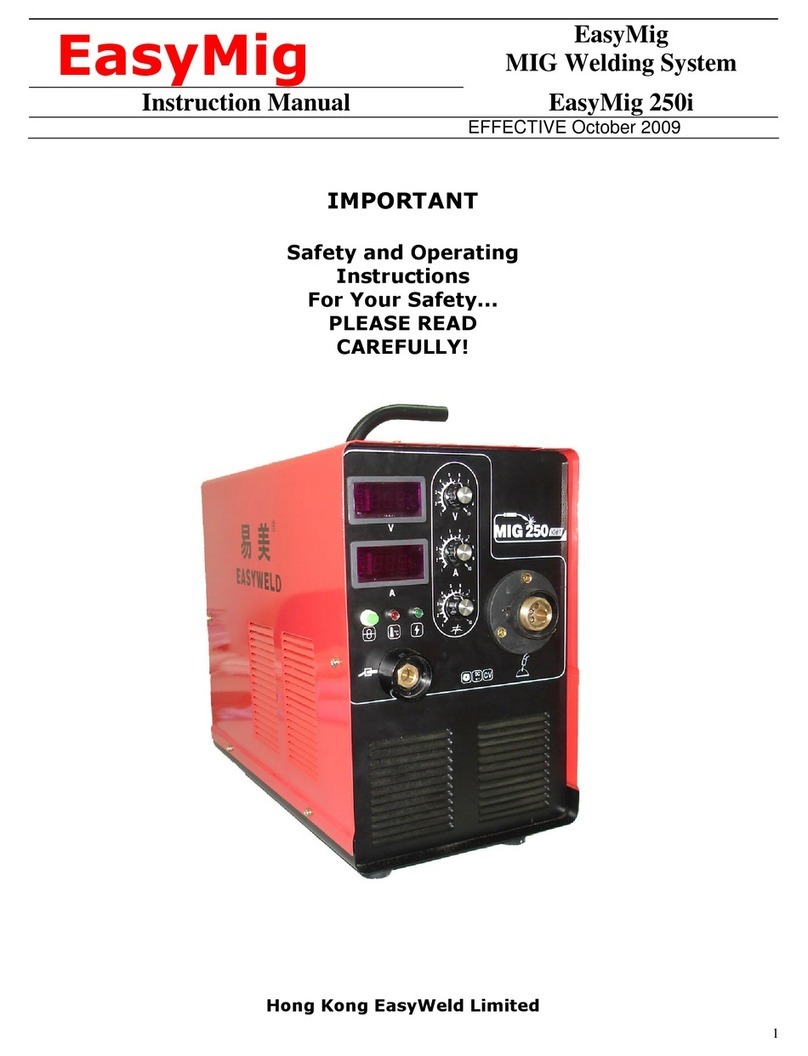
Hong Kong Easyweld
Hong Kong Easyweld EasyMig 250i instruction manual
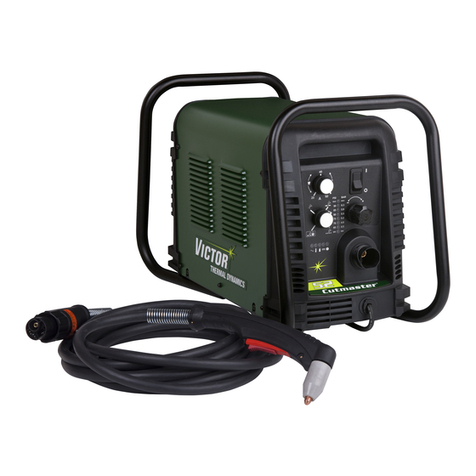
Victor
Victor Cutmaster 52 operating manual
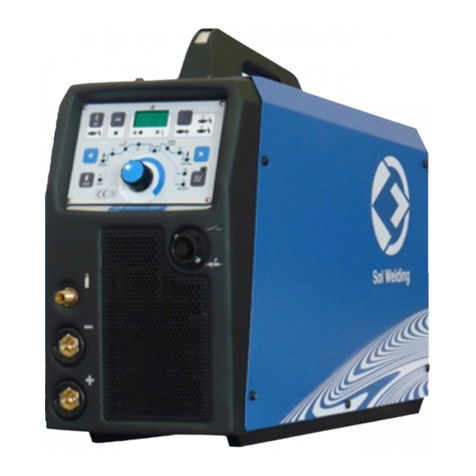
Sol Welding
Sol Welding INOXA SERIES instruction manual
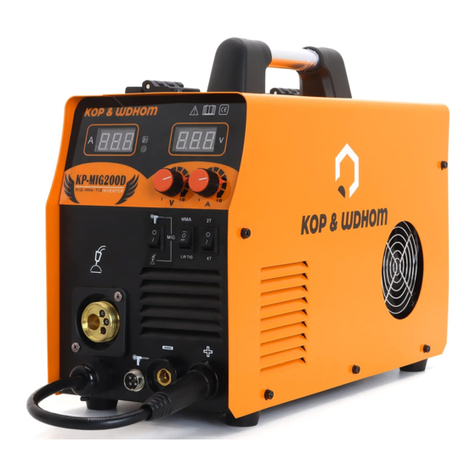
KOP & WDHOM
KOP & WDHOM KP-MIG200D Operation manual
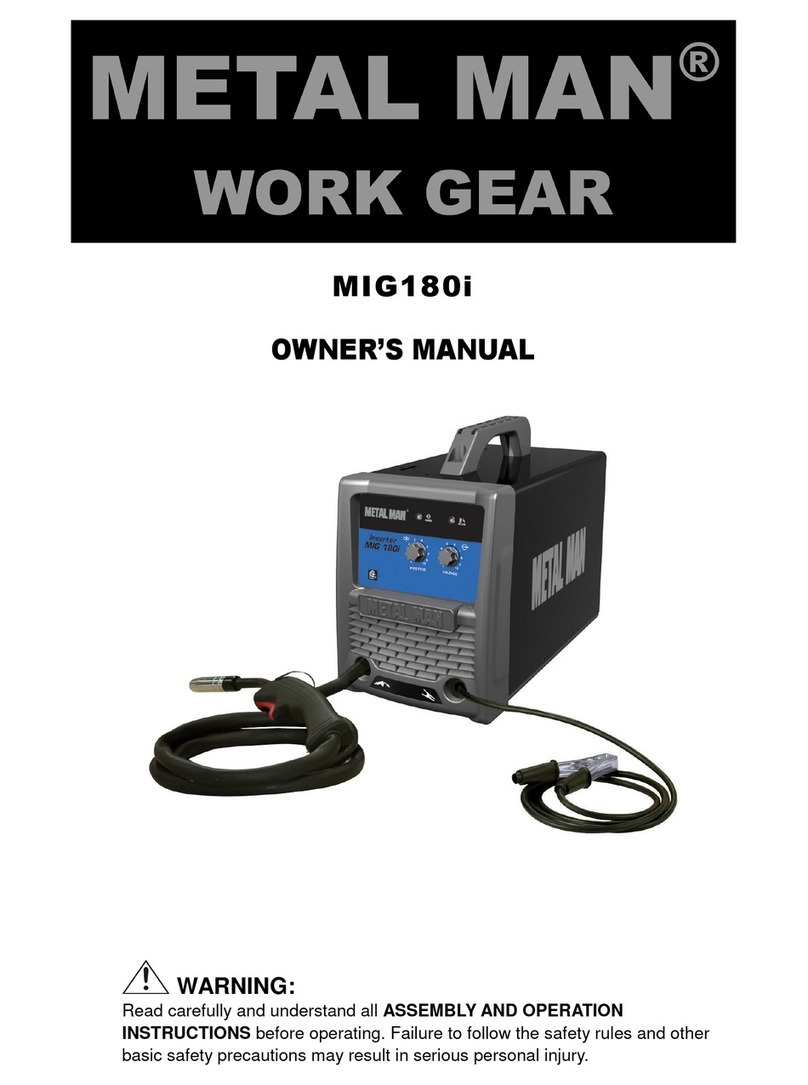
Metal Man
Metal Man MIG180i owner's manual

Miller Electric
Miller Electric OM-4409 owner's manual

Miller Electric
Miller Electric Bobcat 225 owner's manual
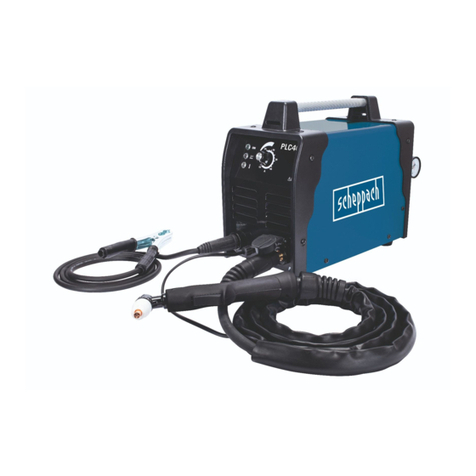
Scheppach
Scheppach PLC40 Translation of original instruction manual
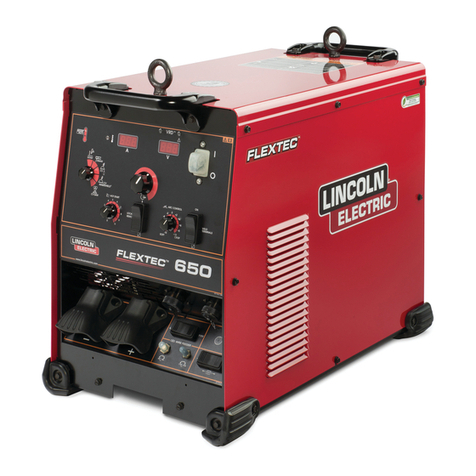
Lincoln Electric
Lincoln Electric FLEXTECTM 650 Operator's manual

Cebora
Cebora HV-14 instructions
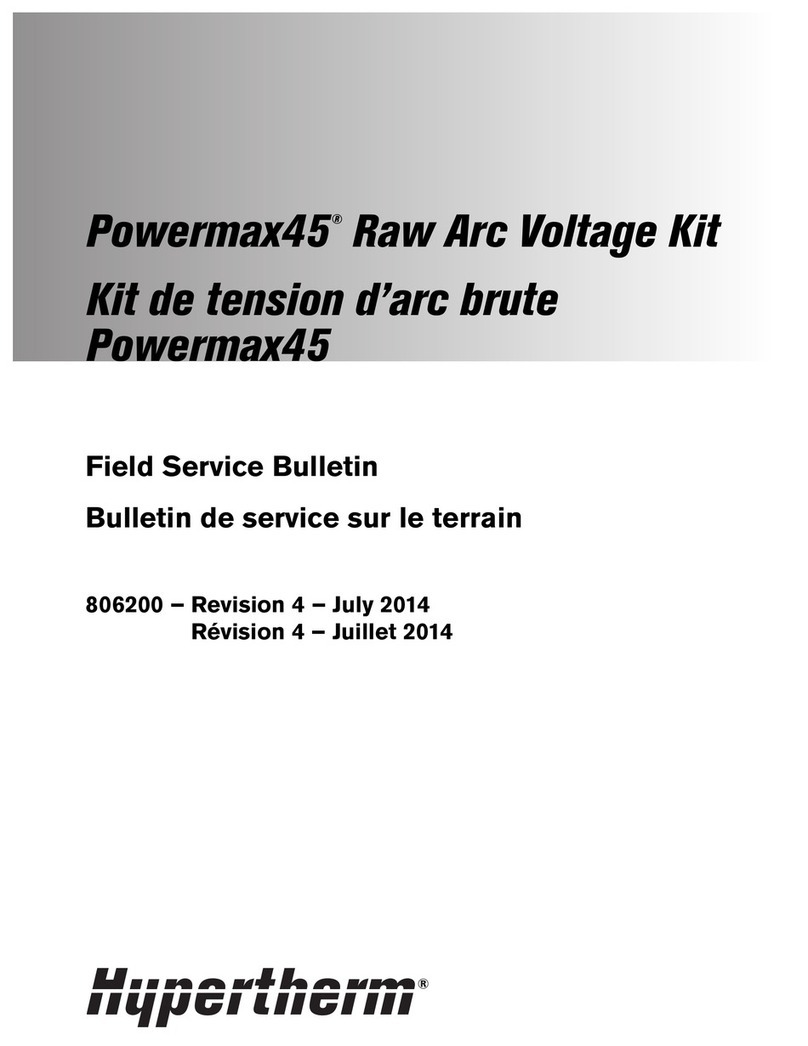
Hypertherm
Hypertherm POWERMAX 45 Field Service Bulletin
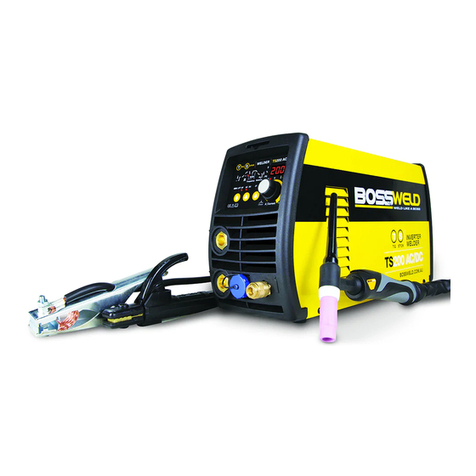
BossWeld
BossWeld TS200 manual
